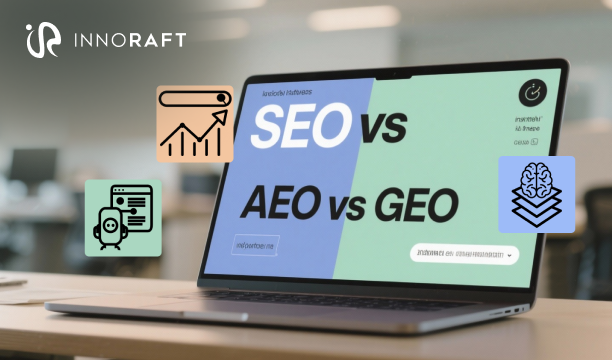Answer Engine Optimization (AEO) and Search Engine Optimization (SEO) are crucial digital marketing strategies aimed at enhancing a business's online visibility. While SEO has been a long-standing practice, AEO is a more recent development, emerging with the growing adoption of AI.
With increased propaganda that SEO is dead and AEO is taking its place, it's more vital than ever to understand the difference between AEO and SEO and whether they are related.
This article will help clarify the differences between AEO and SEO by exploring the following topics:
What is AEO?
Answer Engine Optimization (AEO) is an advanced strategy aimed at providing direct and concise answers to user queries within search engines. This approach is gaining traction as search engines increasingly offer instant, summarized replies, keeping users on a single page. Understanding what is AEO in digital marketing is key to modern visibility.
By optimizing your content and website for AEO, you enhance brand visibility on AI-powered answer engines such as Microsoft Copilot, ChatGPT, and Perplexity. It also ensures your content aligns with modern search behaviors, making it more likely to appear in Google AI overviews, AEO for voice search optimization, and structured data.
AEO future-proofs your website by adapting it to the shift towards AI-driven search tools and improving the user experience. Optimizing for answer engines involves building upon established SEO best practices, including the strategic use of keywords and the creation of authentic, high-quality content.
What is SEO?
Search engine optimization (SEO) is a long-standing method that helps websites achieve high rankings on search engines, thereby attracting more traffic and generating leads and conversions.
SEO services enhance a business's organic visibility on the search engine results pages (SERPs) of traditional search engines like Google and Bing. An effective SEO vs AEO in digital marketing strategy understands that SEO is beneficial across all stages of the marketing funnel, from attracting qualified traffic during the awareness stage to driving conversions in the action stage.
What are the Primary Differences between AEO and SEO?
Both AEO and SEO share similarities, yet they diverge significantly in their primary objectives, focus, and implementation. The following explores the fundamental AEO and SEO comparison in detail.
Contrasting Goals in Digital Marketing
Traditionally, SEO has focused on improving website rankings in search engine results to increase organic traffic. AEO aims to provide direct and precise answers to users of AI-powered search engines.
A key Difference between AEO and SEO is that AEO does not prioritize driving users to websites. Instead, it optimizes content for direct display in features like snippets, Google AI overviews, knowledge graphs, and voice search responses. While SEO effectively attracts users to websites, leading to leads and conversions, AEO excels at building trust and authority by delivering quick and direct information, showcasing the distinct importance of AEO.
Optimization Methods
SEO Optimization Tactics:
- Keyword Strategy: Involves meticulous keyword research and strategic placement to align with user search queries.
- Link Building: Focuses on backlinking and building strong external links to improve domain authority.
- Metadata Enhancement: Optimizing metadata to attract relevant organic traffic.
- User Experience (UX): Improving user experience through fast loading speeds and mobile-friendly design.
AEO Optimization Methods:
- Modern Search Alignment: Tailoring content to align with contemporary search behaviors.
- Answer-Centric Structuring: Structuring content to provide direct answers upfront.
- Value-Driven Content: Prioritizing valuable content for users over mere keyword matching.
- Authority Building: Establishing credibility through clear, concise, and well-structured content.
- Structured Data Integration: Utilizing structured data like schema markup to facilitate content indexing by answer engines.
Content Formats: SEO vs. AEO
SEO primarily targets long-form content such as blogs, articles, and webinars, allowing for extensive keyword integration and detailed optimization. In contrast, AEO prioritizes concise content snippets that AI language models can easily summarize.
Examples of AEO-friendly content formats include:
- Frequently Asked Questions (FAQs): These sections address common inquiries about a business's products, services, or the company itself.
- Featured Snippets: Short excerpts appearing at the top of Google search results pages. Optimization involves directly answering questions, using clear and concise language, and enhancing readability with lists and tables.
- People Also Ask (PAA): This section displays related questions and answers. To appear here, incorporate an FAQ, utilize question-based headings, and provide brief responses.
- Schema Markups (Structured Data): Code added to a website's HTML that helps search engines understand and index web pages more effectively.
User Search Behaviors
AEO adapts to evolving search behaviors, moving beyond traditional text-based searches to embrace voice and conversational queries. It focuses on providing direct, concise answers for modern context-based searches, dramatically improving how AEO improves search visibility.
Conversely, SEO excels with keyword-focused, text-based searches, targeting a broad audience seeking detailed information and inclined to explore further on a website. AEO is particularly beneficial for users of mobile devices, voice assistants like Alexa, Siri, and Google Home, or AI-powered chatbots.
Conclusion: The Synergy of AEO and SEO
The transition to AI-driven search doesn't eliminate the need for Search Engine Optimization; it simply refines it. AEO and SEO are not competing forces but complementary strategies.
- SEO builds the necessary foundation of authority, technical excellence, and traffic.
- AEO ensures that the high-quality content created through SEO is specifically packaged to win zero-click answers and conversational search results.
In modern digital marketing, success lies in a holistic approach. By skillfully combining robust SEO vs AEO strategies, businesses can ensure they capture both the click-through traffic of traditional search and the instant-answer visibility of modern answer engines.
Ready to future-proof your visibility? Contact us today to create an integrated SEO and AEO strategy that dominates both search outcomes and instant answers.
FAQ
Frequently Asked Questions
Didn’t find what you were looking for here?


